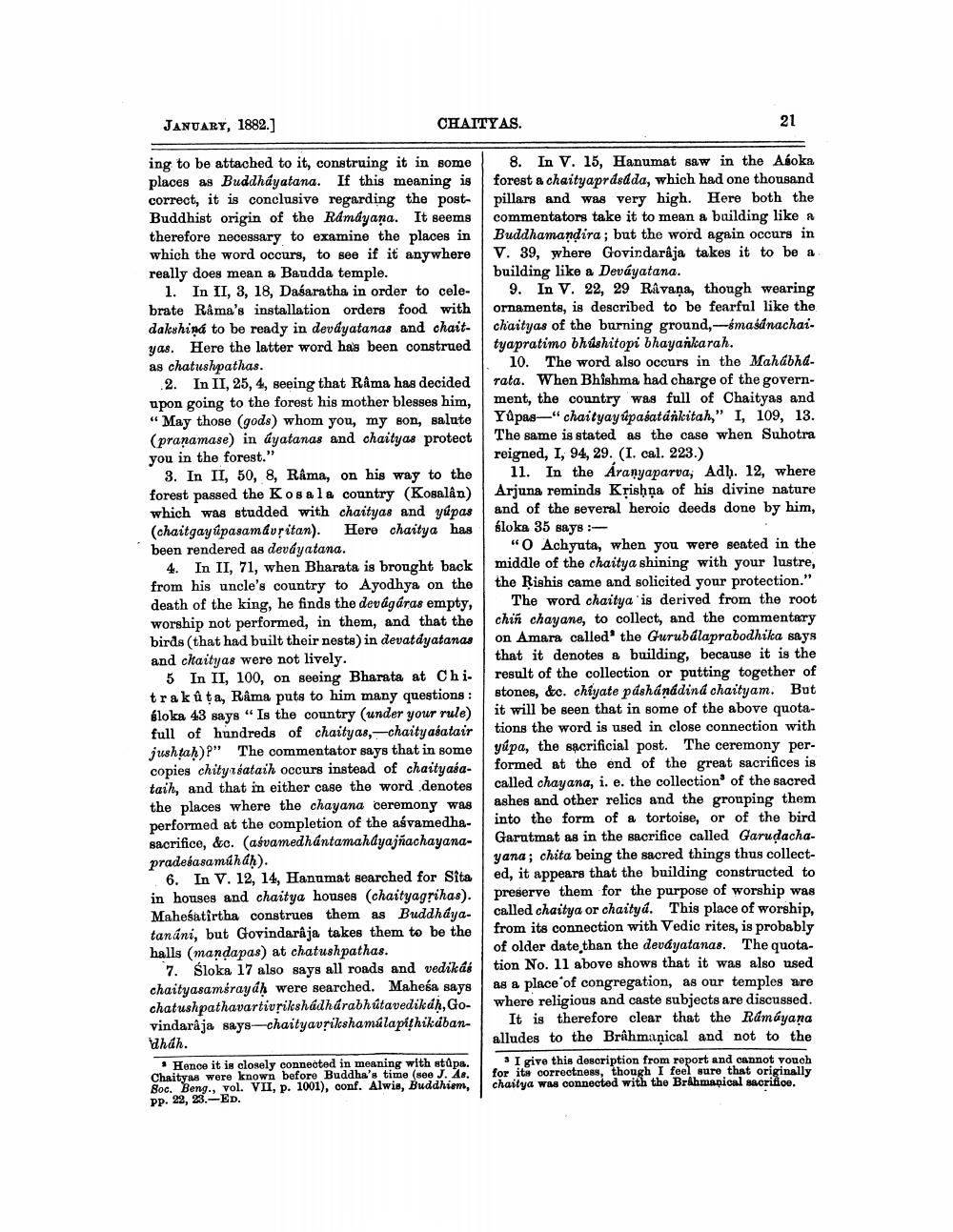________________
JANUARY, 1882.]
CHAITY AS.
21
ing to be attached to it, construing it in some places as Buddháyatana. If this meaning is correct, it is conclusive regarding the post- Buddhist origin of the Ramayana. It seems therefore necessary to examine the places in which the word occurs, to see if it anywhere really does mean a Baudda temple.
1. In II, 3, 18, Dasaratha in order to celebrate Rama's installation orders food with dakshina to be ready in devdyatanas and chaityas. Here the latter word has been construed as chatushpathas.
2. In II, 25, 4, seeing that Rama has decided upon going to the forest his mother blesses him, "May those (gods) whom you, my son, salute (pranamase) in byatanas and chaityas protect you in the forest."
3. In II, 50, 8, Rama, on his way to the forest passed the Kosala country (Kobalân) which was studded with chaityas and yupas (chaitgayłpasamdvritan). Here chaitya has been rendered as devdyatana.
4. In II, 71, when Bharata is brought back from his uncle's country to Ayodhya on the death of the king, he finds the devágáras empty, worship not performed, in them, and that the birds (that had built their nests) in devatdyatanas and chaityas were not lively.
5 In II, 100, on seeing Bharata at Chi. trak û ta, Rama puts to him many questions : bloka 43 says “Is the country (under your rule) full of hundreds of chaityas,-chaity asatair jushtah)P" The commentator says that in some copies chityn sataih occurs instead of chaityasatain, and that in either case the word denotes the places where the chayana ceremony was performed at the completion of the aśvamedhasacrifice, &c. (ašvamedhántamahdyajñachayanapradeśasamihah).
6. In V. 12, 14, Hanumat searched for Sita in houses and chaitya houses (chaityagrihas). Mahesatirtha construes them as Buddhdyatanáni, but Govindaraja takes them to be the halls (mandapas) at chatushpathas.
7. Sloka 17 also says all roads and vedikas chaityasamsrayah were searched. Mahesa says chatushpathavartivrikshadhárabhutavedikdh, Govindaraja says-chaityavrikshamalapithikdbanWháh.
Hence it is closely connected in meaning with stapa. Chaityas were known before Buddha's time (see J. Ae. Boc. Beng., vol. VII, p. 1001), conf. Alwis, Buddhism, Pp. 22, 23.-ED.
8. In V. 15, Hanumat saw in the Asoka forest a chaityaprdsdda, which had one thousand pillars and was very high. Here both the commentators take it to mean a building like a Buddhamandira; but the word again occurs in V. 39, where Govindaraja takes it to be a building like a Devayatana.
9. In V. 22, 29 Råvaņa, though wearing ornaments, is described to be fearful like the chaityas of the burning ground, ---emasanachai. tyapratimo bhushitopi bhayankarah.
10. The word also occurs in the Mahabharata. When Bhishma had charge of the government, the country was full of Chaityas and Yapas-"chaityay úpasatánkitah," I, 109, 13. The same is stated as the case when Suhotra reigned, I, 94, 29. (I. cal. 223.)
11. In the Aranyaparva, Adh. 12, where Arjuna reminds Kļishna of his divine nature and of the several heroic deeds done by him, sloka 35 says :
"O Achyuta, when you were sented in the middle of the chaitya shining with your lustre, the Rishis came and solicited your protection."
The word chaitya is derived from the root chin chayane, to collect, and the commentary on Amara called the Gurubálaprabodhika says that it denotes & building, because it is the result of the collection or putting together of stones, &c. chiyate pushånddind chaityam. But it will be seen that in some of the above quotations the word is used in close connection with yúpa, the sacrificial post. The ceremony performed at the end of the great sacrifices is called chayana, i. e. the collection of the sacred ashes and other relics and the grouping them into the form of a tortoise, or of the bird Garutmat as in the sacrifice called Garudachayana; chita being the sacred things thus collected, it appears that the building constructed to preserve them for the purpose of worship was called chaitya or chaity. This place of worship, from its connection with Vedic rites, is probably of older date than the deváyatanas. The quotation No. 11 above shows that it was also used as a place of congregation, as our temples are where religious and caste subjects are discussed.
It is therefore clear that the Ramayana alludes to the Brahmaņical and not to the
II give this description from report and cannot vouch for its correctness, though I feel sure that originally chaitya was connected with the Brahmapical sacrifice.




